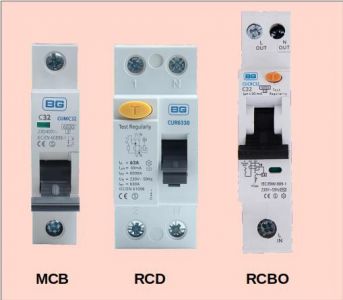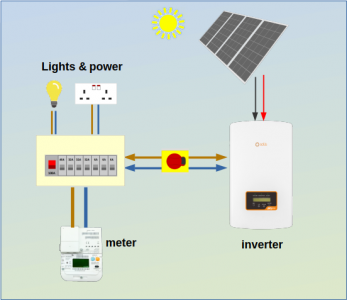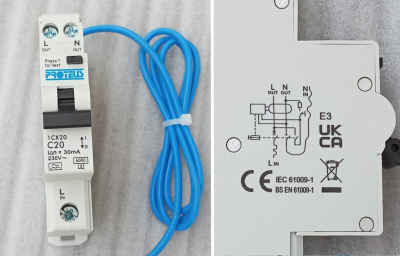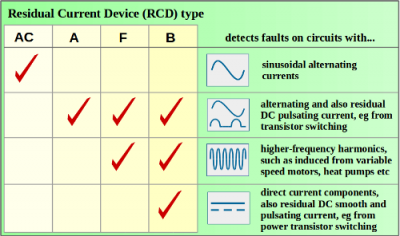Safety update; RCBOs supplying inverters or storage batteries
BEAMA have issued a safety update (March 2024) regarding the use of RCBOs to connect PV inverters or storage batteries.
This is not yet part of the IET Electrical Wiring Regulations, but it is sufficiently serious that an amendment is being expedited.
Overview: household electrical circuits are wired from a Consumer Unit which contains a number of trips.
Most trips are there to prevent excessive current being passed through wires/cables. Those are MCBs (Miniature Circuit Breakers).
It is common for a consumer unit to have one or more RCDs (Residual Current Detectors).
These compare the outgoing current on the Live wire, with that being returned on the Neutral.
If there is an imbalance, the contacts will open to prevent fire or electric shock to someone who has touched a live cable.
Increasingly, electricians are fitting RCBOs for individual power circuits.
These combine the functions of an MCB and RCD.
They will open the contacts either for over-current, or because current is leaking away somewhere.
If a single-circuit RCBO trips out, then at least the lights remain on so you can see what's gone wrong!
RCDs and RCBOs both have a test button.
This should be pressed periodically to check that it will open the contacts to protect against electric shock
When solar panels or storage batteries are installed, it is not mandatory that the circuit is supplied from an RCBO. An MCB is sufficient.
However, many installers do use an RCBO to provide an extra level of safety for when it might be necessary for an inverter to undergo maintenance.
Most Solar Inverters and Storage Batteries are "Grid tied".
They export to the mains supply through the same wires which connect them to the consumer unit.
A grid-tied inverter will have a G98 certificate, and requires permission from the regional DNO to install it.
This common arrangement means that electricity will pass through the RCBO in either direction.
The RCBO contains a small amount of electronics to handle the current sensing.
When there is a fault (either over-current or earth-leakage) a solonoid is energised (switched on), which opens the contacts.
If the RCBO was on a normal power circuit, opening the contacts would remove power from the electronics.
The trip would remain open until the lever was manually moved, and the solonoid would no longer be powered-on.
But if there is power still being applied in the reverse direction by an inverter or storage battery, when the contacts open, the solonoid remains energised.
Such a small solonoid will overheat and burn out.
The circuit can still be re-powered using the lever, but it will no longer be able to protect against electric shock.
The home owner won't know that.
The solution is to use a an RCBO specifically designed for bi-directional use.
A bi-directional RCBO has a third pair of contacts.
When the solonoid operates to open the trip, that 3rd contact set removes power from the electronics, and the solonoid coil is de-energised, preventing burn-out.
How can you tell if an RCBO is bi-directional?
Most RCBOs have arrows to show the direction of current, or have a label which denotes Supply and Load terminals.
A Bi-directional RCBO will not be marked for Supply and Load.
It may also have a set of arrows pointing in both directions.
If an RCBO isn't marked as being bi-directional, then it isn't.
The IET Wiring Regulations aren't retrospective.
When the amendment is released which specifies the need for a bi-directional RCBO, there will still be many thousands of installations which appear to have an operational RCBO, but it will only offer protection against over-current. It won't be acting to prevent fire or avoid electric shock.
It is up to forum members here to spread the word to others and advise that an existing RCBO is exchanged (by an electrician!) for a bi-directional type.
Save energy... recycle electrons!
This photo shows a bi-directional RCBO by Proteus at Redditch.
The symbols are correct, and the third-contact which the solonoid switches is visible in the diagram on the side.
What I still don't like is:
- the terminals being labelled 'In' and 'Out'
- no bi-directional symbol or marking on the part of the RCBO which remains visible to the householder after installation is completed
This particular RCBO is Type A
and Curve C... which defines the time it takes to trip due to over-current.
Most household MCBs and RCBOs are curve-B, which operates faster.
I use Curve-C trips to supply circuits which are likely to have large inductances connected (motors in a workshop or an inverter).
Update 28may24:
I have a response from Proteus Switchgear to say that they are already acting on the BEAMA directive and "will remove the in/out and also add on a bidirectional arrow symbol to the front of compliant devices"
The changes will filter through once existing stocks have been exhausted.
Save energy... recycle electrons!
- 26 Forums
- 2,153 Topics
- 47.3 K Posts
- 38 Online
- 5,673 Members
Podcast Picks
Latest Posts
-

RE: Midea ASHP – how to set weather compensation
@pash44pump - to collect the IAT/OAT data, can I sugges...
By cathodeRay , 47 minutes ago
-

RE: Ecodan software update. Real or scam?
@vinz86 Contact Mitsubishi and an engineer attends and ...
By ASHP-BOBBA , 11 hours ago
-

My Samsung Gen6 (probably same controller as yours) onl...
By Old_Scientist , 21 hours ago
-

@drei When I was in local government we were of cours...
By JamesPa , 21 hours ago
-

RE: Heat Pump SCOPs – The Truth Might Not Be What You Think
Sufficient system volume is also essential for ensuring...
By Old_Scientist , 23 hours ago
-

RE: Boiling Mad: Exposing Radiatorgate
@rob-nezard you can see more of Drei's rad dramas here ...
By Mars , 23 hours ago
-

RE: A Customer's Lessons Learnt from a Heat Pump Installation in a Large House
@drei I will say again that Im sorry to heat about your...
By JamesPa , 24 hours ago
-

RE: Flexi-Orb Heat Pump Scheme: A Game-Changer for the UK's Heat Pump Industry
As someone who has suffered from a Heat Pump installati...
By DREI , 1 day ago
-

RE: Solar Power Output – Let’s Compare Generation Figures
1040kw Even beat June and July. Great month.
By Andris , 1 day ago
-

RE: New Vaillant aroTherm Plus in black - When will it come to the UK?
Hope they know what they're doing regarding paint types...
By PatrickVito , 2 days ago
-

RE: What crazy nonsense are inverter limits and why are they imposed?
I’ve also got a dual fuel Rangemaster. We originally ha...
By Majordennisbloodnok , 2 days ago
-

RE: Octopus tariffs - a quick comparison
@tim441 I’d agree wholeheartedly with that, with 2 x Po...
By Toodles , 2 days ago
-

RE: Electricity price predictions
@bontwoody Maybe one for @editor to consider whether a ...
By ChandyKris , 2 days ago
-

RE: is a home battery without an EV worth it?
You would think, but when I had my Powerwall 3 installe...
By Old_Scientist , 2 days ago
-

@mars That response surely deserves a nomination for Tu...
By JamesPa , 2 days ago
-

Specifying batteries, pv solar etc using ChatGPT
I thought I'd try to use ChatGPT to specify my requirem...
By Tim441 , 3 days ago
-

RE: Ecodan & MelCloud scheduling
When I interviewed Mitsubishi Electric at Installer ear...
By Mars , 3 days ago
-

RE: Rodents! A word of warning for heat pump owners
@lucia One look at that protection and the rodents will...
By Toodles , 3 days ago







